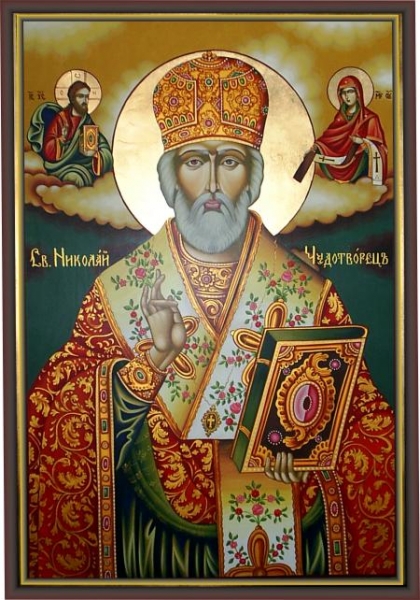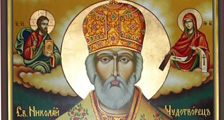Bulgarian Orthodox Church „St. Nikolai Wonderworker“ – San Diego
Our Patron Saint
 Saint Nicholas (Bulgarian: Св. Николай Мирликийски Чудотворец, Greek: Ἅγιος Νικόλαος, Hagios Nikólaos, Latin: Sanctus Nicolaus) is also called St. Nicholas of Myra. Because of the many miracles attributed to his intercession, he is also known as St. Nicholas the Wonderworker
Saint Nicholas (Bulgarian: Св. Николай Мирликийски Чудотворец, Greek: Ἅγιος Νικόλαος, Hagios Nikólaos, Latin: Sanctus Nicolaus) is also called St. Nicholas of Myra. Because of the many miracles attributed to his intercession, he is also known as St. Nicholas the Wonderworker
St. Nicholas was born in the second half of III-rd century in Patara, a city in Lycia region, Asia Minor. Since childhood he possesed the virtues of great faith, rightness and grace which glorified him before God and men.
Nicholas would take nourishment only once on Wednesdays and Fridays, and that in the evening according to the canons. “He was exceedingly well brought up by his parents and trod piously in their footsteps. The child, watched over by the church, enlightened his mind and encouraged his thirst for sincere and true religion.” When he reached adolescence, his uncle, Nikolai, Bishop of Patara, persuaded his parents to devote their son to the worship of God. Both of his parents tragically died during an epidemic when he was a young man, leaving him well off, but to be raised by his uncle – the Bishop of Patara. Nicholas was determined to devote his inheritance to works of charity, and his uncle mentored him as a reader and later ordained him as a presbyter (priest).
Coming to the city of Myra when the clergy and people of the province were in session to elect a new bishop, St. Nicholas was indicated by God as the man they should choose. This was during the time of persecutions in the beginning of the fourth century and “as he [Nicholas] was the chief priest of the Christians of this town and preached the truths of faith with a holy liberty, the divine Nicholas was seized by the magistrates, tortured, then chained and thrown into prison with many other Christians. But when the great and religious Constatine, chosen by God, assumed the imperial diadem of the Romans, the prisoners were released from their bonds and with them the illustrious Nicholas, who when he was set at liberty returned to Myra.”
At the time of his ordination, the Bishop, filled with prophetic spirit, turned to the people and exclaimed: “Brothers! I see a new Sun, which rises over the Earth and promises comfort to all grieving. Blessed the flock that will have him for their shepherd, because he will bring the truth to the wayward, they graze on range of piety and will be an aid to all sufferers!” St. Nicholas’s whole life was the performance of these prophetic words: he never stopped helping the sufferers, protecting the innocent, fortifying the weak with the word of truth and faith.
After the death of his parents he gave away all his rich heritage for good deeds, trying not to revieal himself as the savior of those who he favored. He always remembered God’s commandment – to do good without looking for glory.
An opportunity soon arose for St. Nicholas and his inheritance. A citizen of Patara had lost all his money, and needed to support his three daughters who could not find husbands because of their poverty; so the wretched man was going to give them over to prostitution. Nicholas became informed of this, and thus took a bag of gold and threw it into an open window of the man’s house in the night. Here was a dowry for the eldest girl and she was soon duly married. At intervals Nicholas did the same for the second and the third. The father, overwhelmed with joy, praised the Lord.
Several stories tell of Nicholas and the sea. When he was young, Nicholas sought the God by making a pilgrimage to the Holy Land. There as he walked where Jesus walked, he sought to more deeply experience Jesus’s life, passion, and resurrection. Returning by sea, a mighty storm threatened to wreck the ship. Nicholas calmly prayed. The terrified sailors were amazed when the wind and waves suddenly calmed, sparing them all. And so St. Nicholas is the patron of sailors and voyagers.
Other stories tell of Nicholas saving his people from famine, sparing the lives of those innocently accused, and much more. He did many kind and generous deeds in secret, expecting nothing in return. Within a century of his death he was celebrated as a saint.
The historical Saint Nicholas is commemorated and revered among Orthodox, Catholic, Anglican, and Lutheran Christians. In addition, some Baptist, Methodist, Presbyterian, and Reformed churches have been named in honor of Saint Nicholas. In Bulgaria alone, there are more than 50 churches, monasteries and chapels named after our patron.
Today he is venerated in the East as wonder, or miracle worker and in the West as patron of a great variety of persons-children, mariners, bankers, pawn-brokers, scholars, orphans, laborers, travelers, merchants, judges, paupers, marriageable maidens, students, sailors, victims of judicial mistakes, captives, perfumers, even thieves and murderers! He is known as the friend and protector of all in trouble or need.
The great veneration with which St. Nicholas has been honored for many ages and the number of altars and churches all over the world that are dedicated in his memory are testimonials to his wonderful holiness and the glory he enjoys with God. As an episcopal see, and his childhood church falling vacant, the holy Nicholas was chosen bishop, and in that station became famous by his extraordinary piety and zeal and by his many astonishing miracles. It is said that St. Nicholas died in Myra, and was buried in his cathedral.
The accounts are unanimous that St. Nicholas died and was buried in his episcopal city of Myra, and by the time of Justinian, there was a basilica built in his honor at Constantinople.
At Myra “the venerable body of the bishop, embalmed as it was in the good ointments of virtue exuded a sweet smelling myrrh, which kept it from corruption and proved a health giving remedy against sickness to the glory of him who had glorified Jesus Christ, our true God.” The translation of the relics did not interrupt this phenomenon, and the “manna of St. Nicholas” is said to flow to this day. It was one of the great attractions that drew pilgrims to his tomb from all parts of Europe.
Nicholas’ tomb in Myra became a popular place of pilgrimage. Because of the many wars and attacks in the region, some Christians were concerned that access to the tomb might become difficult. For both the religious and commercial advantages of a major pilgrimage site, the Italian cities of Venice and Bari vied to get the Nicholas relics. In the spring of 1087, sailors from Bari succeeded in spiriting away the bones, bringing them to Bari, a seaport on the southeast coast of Italy. An impressive church was built over St. Nicholas’ crypt and many faithful journeyed to honor the saint who had rescued children, prisoners, sailors, famine victims, and many others through his compassion, generosity, and the countless miracles attributed to his intercession. The Nicholas shrine in Bari was one of medieval Europe’s great pilgrimage centers and Nicholas became known as “Saint in Bari.” To this day pilgrims and tourists visit Bari’s great Basilica di San Nicola.
The image of St. Nicholas is, more often than any other, found on Byzantine seals. In the later middle ages nearly four hundred churches were dedicated in his honor in England alone, and he is said to have been represented by Christian artists more frequently than any saint, except our Lady.
St. Nicholas is celebrated as the patron saint of several classes of people, especially, in the East, of sailors and in the West of children. The first of these patronage is most likely due to the legend that during his lifetime, he appeared to storm tossed mariners who invoked his aid off the coast of Lycia and brought them safely to port. Sailors in the Aegean and Ionian seas, following a common Eastern custom, had their “star of St. Nicholas” and wished one another a good voyage in the phrase “May St. Nicholas hold the tiller.”
Curiously enough, the greatest popularity of St. Nicholas is found neither in the eastern Mediterranean nor north-western Europe, but in Russia. With St. Andred the Apostle, he is patron of the nation, and the Russian Orthodox Church even observes the feast of his translation; so many Russian pilgrims came to Bari before the revolution that their government supported a church, hospital and hospice there.
He is also the patron saint of Greece, Apulia, Sicily and Loraine, and of many citiesand dioceses (including Galway) and churches innumerable. At Rome the basilica of St. Nicholas in the Jail of Tully (in Carcere) was founded between the end of the sixth and the beginning of the seventh centuries. He is named in the preparation of the Byzantine Mass. St. Nicholas became recognized as a saint long before the Roman Catholic Church began the regular canonizing procedures in the late 10th century. Therefore, he does not have a specific date of canonization, rather records of him exist in a gradual spread until his stories became widley known and celebrated. St. Nicholas’ feast day is December 6.
Through the centuries St. Nicholas has continued to be venerated by Catholics and Orthodox and honored by Protestants. By his example of generosity to those in need, especially children, St. Nicholas continues to be a model for the compassionate life.
Sources:
